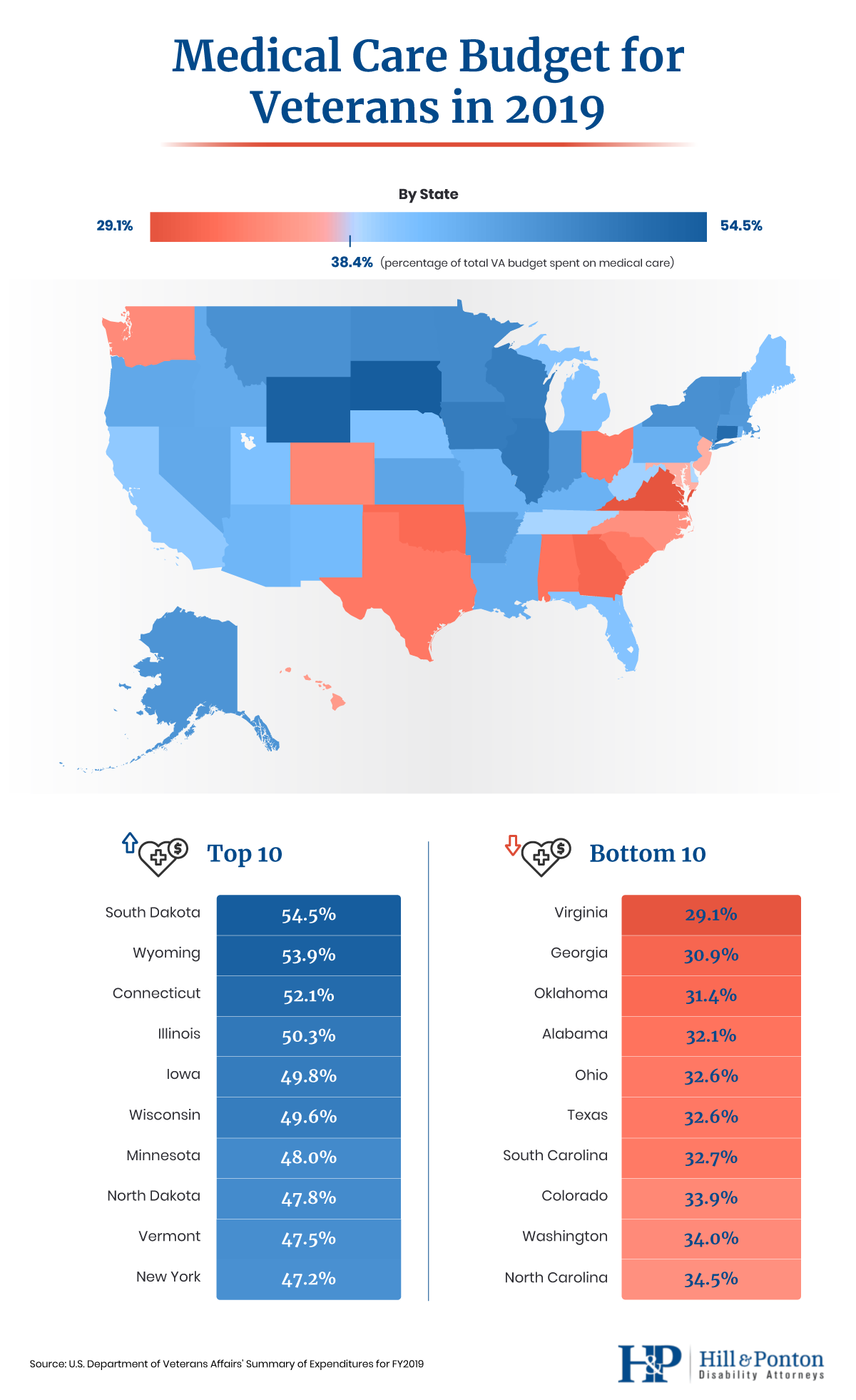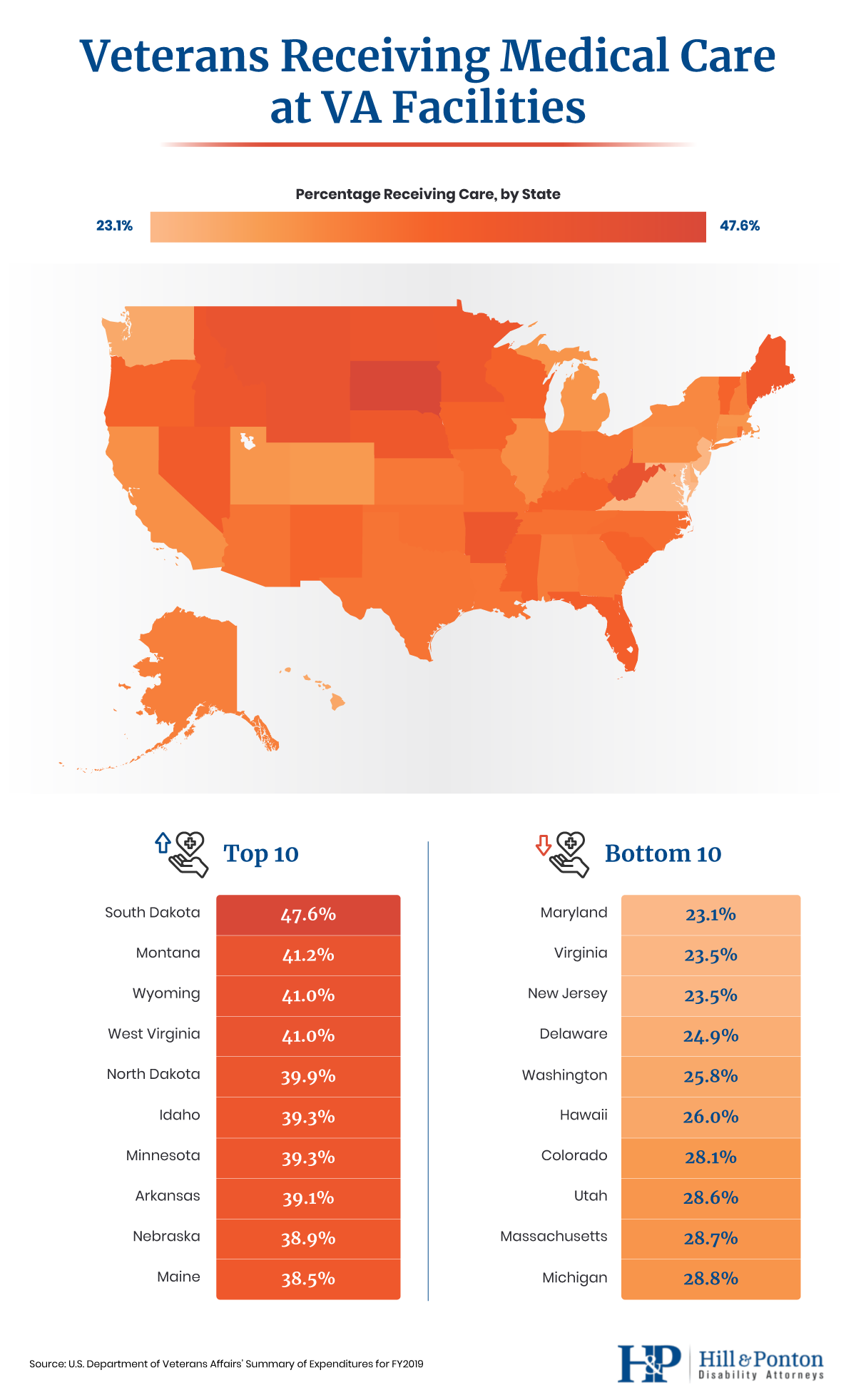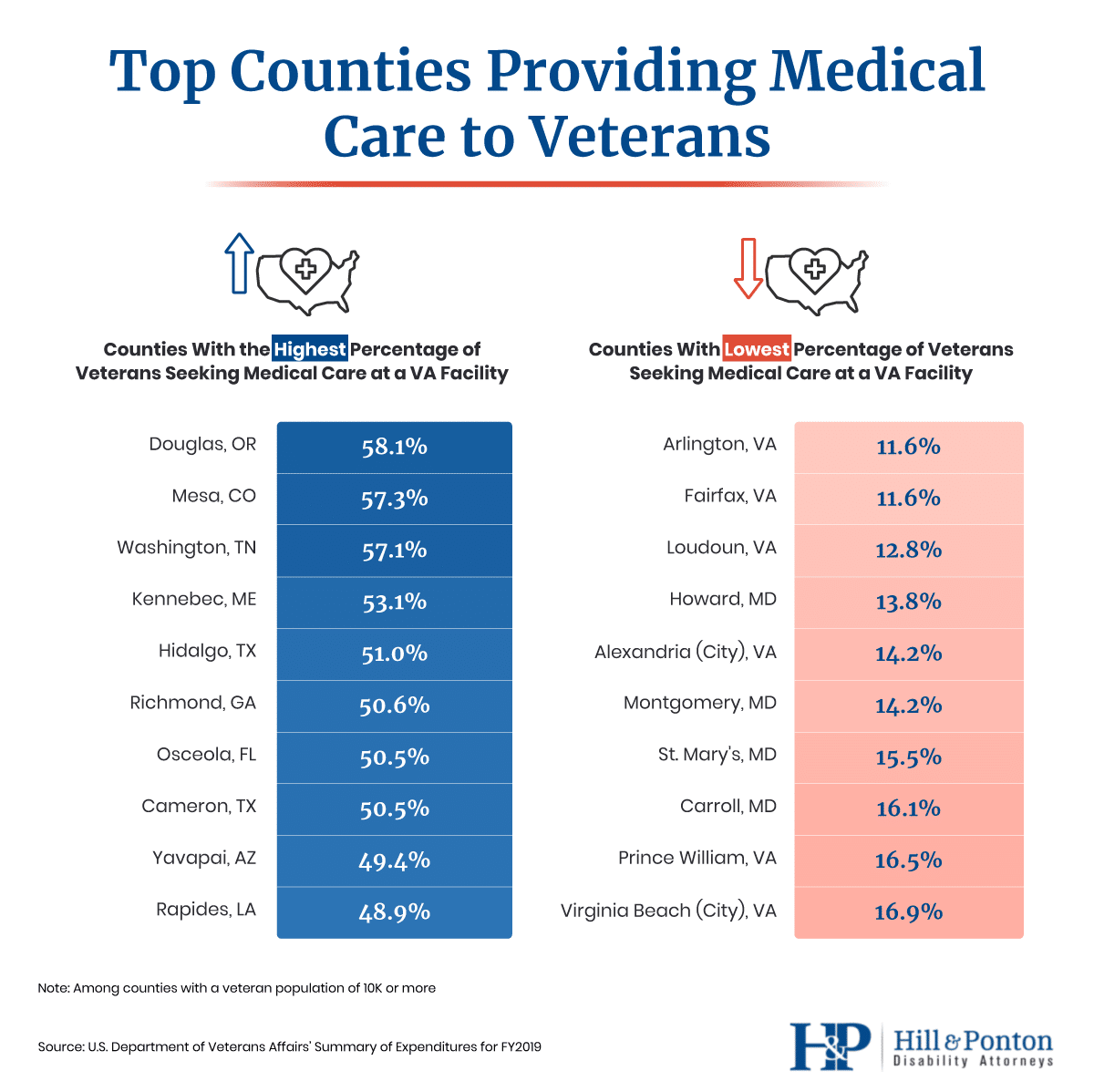
The U.S. Department of Veterans Affairs requested a 10.2% increase in its budget for fiscal year 2021. Included in the plan for these additional funds is a $13.5 billion increase in funds for health care, benefits, and national cemeteries. An increase in benefits funding would be a big win for veterans across the nation, but it won’t mean nearly as much if you have to wait through a backlog to receive those benefits.
In 2013, NPR reported that veterans were waiting an average 273 days to receive benefits. Seven years later, how have things changed? To learn about the modern state of veterans’ affairs, we looked at the U.S. Department of Veterans Affairs Summary of Expenditures for 2019. We broke the data down by state and then by county to see which states have the majority of their budgets allocated to veterans’ medical benefits and which states focus their spending elsewhere. Keep reading to see what we discovered about the current state of veterans’ medical benefits in the U.S.
The State of Veterans’ Affairs in the U.S.

The Department of Veterans Affairs estimates the spending of major VA programs at the state, county, and congressional district levels in various categories, such as compensation and pension, education and vocational rehabilitation, and medical care. In 2019, VA programs spent around $202 billion on the 19.1 million veterans in the United States.
At almost half of all VA spending, veteran compensation and pension spending was the biggest expenditure in 2019. This includes spending on veterans compensation for service-connected disabilities, dependency and indemnity compensation (DIC) for service-related deaths, pensions for nonservice-related disabilities, burials, and other benefits to veterans and their survivors.
VA disability compensation provides monthly, tax-free benefits to veterans who were disabled or injured while serving in the military. DIC is a tax-free benefit paid to a surviving spouse, child, or parent of a servicemember who died during military service.
Some veterans qualify for special monthly compensation (SMC), which when warranted by special circumstances, such as a severe disability, pays an additional benefit to veterans or their family.
The second largest portion of VA program spending went to medical care, at just over 38% of all VA spending in 2019. VA medical care is provided on a case-by-case basis with each veteran’s benefits package unique to the recipient. All packages include coverage for services like treating illness and injuries, preventive care, and care to improve quality of life. Some may include additional benefits such as dental care. The benefits received depend on the recommendation of a VA primary care provider, the medical standards for treating existing health conditions and priority groups. Priority groups are determined by military service history, disability rating, income level, whether they qualify for Medicaid, and other benefits – like a VA pension – that may be received. You can learn more about priority groups here.
Which States Have the Biggest Budgets for Veteran Medical Care?

VA health care includes regular checkups with primary care providers and appointments with specialists, as well as other services like home health and geriatric care. Veterans can also get medical equipment, prosthetics, and prescriptions.
To get a closer look at how VA medical care varies among states, we compared what percentage of states’ veteran budgets went to medical spending in 2019. South Dakota had the largest allocation for medical care for veterans at 54.5% of its total budget. South Dakota benefits include payment for service connected disabilities and hospital care at VA Medical Centers.
Wyoming, Connecticut, and Illinois also allocated over half of their VA budgets to medical care. On the other end of the spectrum, Virginia allocated the smallest portion of its VA budget to medical care. However, Virginia was the state with the second-largest budget allocation to education and vocational rehabilitation at 12.6%.
Georgia, Oklahoma, Alabama, Ohio, Texas, and South Carolina also allocated less than one-third of their veterans’ benefits budgets to health care.
Where Veterans Are Getting Medical Care?

The proportion of the budget a state allocates to medical benefits may vary depending on demand. States where veterans are more likely to utilize state medical benefits may also use more of their budget toward medical care – based on our findings, this appears to be the case.
South Dakota, which allocated more than 50% of its budget toward medical benefits for veterans in 2019, also had the highest usage rate among its population. Almost 48% of South Dakota veterans sought medical treatment at a VA facility in 2019. Wyoming, which had the second-highest budget allocation to medical care, also had high demand, with 41% of veterans receiving medical treatment at a VA facility.
On the other end of the spectrum, Virginia, with the lowest proportional allocation to VA medical care, also had the second-lowest utilization rate.
These states may have lower utilization rates for a number of reasons. For instance, their residents may not realize they’re eligible for VA benefits. About 25% of uninsured vets don’t know they’re eligible for VA health benefits, according to the U.S. Census Bureau.
Some vets use both private and VA benefits. Most vets use an additional form of health insurance as well as that provided by VA, according to the U.S. Census Bureau. Others may use only private insurance instead of VA benefits, although private insurance usage among veterans has been on the decline while Department of Veterans Affairs medical coverage almost tripled between 2000 and 2016.
Veterans who are old enough to use Medicare also may not utilize VA health benefits. In the last census, about half of veterans across the country were on Medicare, according to the U.S. Census Bureau.
U.S. Counties With the Most Veterans’ Medical Care Usage

To get an even more granular look at veteran medical care across the country, we broke VA medical care usage down by county. We only considered counties with a veteran population of at least 10,000 before looking at the percentage of vets in each that sought medical care at a VA facility in 2019.
Interestingly, none of the states with the highest overall VA medical care utilization or the largest allocation to medical care had a top-utilization county. The county with the highest percentage of veterans seeking medical care at a VA facility in 2019 was Douglas, Oregon. Douglas has around 12,473 veterans out of a population of almost 111,000, or about 11% of the population.
In Arlington, Virginia, veterans account for only 5% of the overall population, and only 11.6% of them sought medical care at a VA facility in 2019. The state also had 6 of the 10 lowest-utilization counties across the country in 2020.
The remaining lowest utilization counties are all in Maryland, which also had the lowest statewide percentage of vets who received care at a VA facility. Howard County, Maryland, with a population that is also about 5% veterans, had only about 14% of its vets receiving care in a VA facility.
Get Veterans the Benefits They’re Due
Despite state and county differences in VA budgets, resources are available to those who served their country. VA health benefits include more than just medical insurance. If you’re a veteran, you should know the benefits available to you – especially if you were disabled or injured while serving. At Hill & Ponton, we help veterans understand and file a claim for the disability benefits available to them.
Time and again we see veterans survive service only to lose the war of fair compensation. Too often the VA acknowledges a disability is service-related but still lowballs the rating of its severity. This can result in veterans missing out on thousands of dollars of benefit compensation. If you think you may be entitled to VA benefits, get a free case evaluation today.
Methodology
Using the U.S. Department of Veterans Affairs’ Summary of Expenditures for fiscal year 2019, we looked at medical care for veterans across the U.S.
Totals for the number of veterans in the U.S. and VA expenditures include Puerto Rico and Guam. However, both were excluded from the rest of our analysis.
State calculations are based on the listed veteran population for each state. These populations are estimates as of September 30, 2019, and are produced by the VA Predictive Analytics and Actuary Service.
The percentage of veterans seeking medical care at VA facilities for each state was calculated by taking the number of unique patients who received treatment at a VA health care facility and dividing it by the total veteran population of the state. A similar calculation was done to get the percentage of veterans receiving medical care at VA facilities by county. When examining the percentage of veterans seeking medical care at a VA facility by county, we confined our analysis to only counties with a veteran population of at least 10,000.
Fair Use Statement
We hope you found the veterans information in this study useful and educational. If you know someone else who would be interested in these findings, we would be glad for you to share it with them. We ask only that when you share it, you do so for noncommercial use and include a link back to this page so that other readers can benefit from the information in its entirety as well. Thank you.




